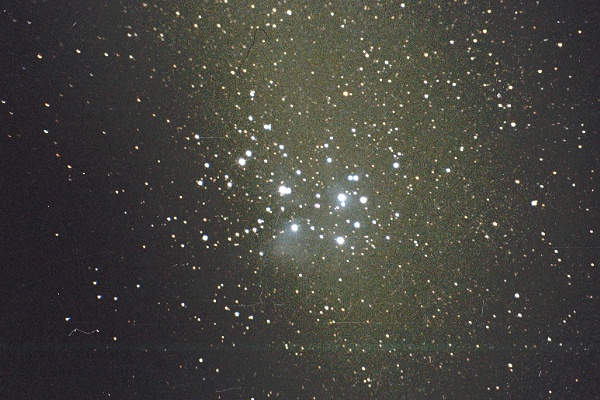|

The Helix Nebula in Aquarius, NGC 7293, photographed at New Mexico Skies Guest Observatory, near
Cloudcroft, over Labor Day weekend, September 5, 1999. New Mexico Skies Guest Observatory is at 7000 feet altitude
in the Sacramento Mountains east of Alamogordo, and near the Sacramento Peak Solar Observatory. This photo was
made using Celestron 80-mm f/5 spotting scope equipped with Lumicon Easy Guider and UV filter. Fifteen minute exposure
on Fuji Color Sensia 800 film using OM-1 camera. The scratches on the negative are courtesy of Fox Photo in Dallas.
Photo Copyright by Ed Flaspoehler

The Pleiades, M45 in Taurus, photographed at New Mexico Skies Guest Observatory, near Cloudcroft,
over Labor Day weekend, September 5, 1999. This photo was made using Celestron 80-mm f/5 spotting scope equipped
with Lumicon Easy Guider and UV filter. Fifteen minute exposure on Fuji Color Sensia 800 film using OM-1 camera.
A slightly longer exposure would have brought out more of the blue nebulosity. It is also possible that the UV
filter cut out some of the blue reflection neblua.
Photo Copyright by Ed Flaspoehler
|
I bought a Celestron ST80 f/5 spotting scope at the Texas Star Party in May 1999. I bought the
scope from Bob Haler of LYMAX
in Kansas City, who was a vendor at this year's TSP. The reason I bought this scope is that I used to have a Soligar
200-mm f/2.8 telephoto lens that I used for wide-field astrophotography. I had great success with that lens, and
took many great photos with it. Unfortunately, that lens was stolen out of my luggage in the Miami Airport when
I took it on my eclipse trip to Bolivia in 1994. I had intened to use it to take pictures of the Magellanic Clouds,
the Eta Carina Nebula, and other southern sky objects. (I used a Meade 2045 for eclipse photography on that trip.)
I felt the loss of my 200-mm dearly.
Then, one day, while paging through the Orion catalog, I stumbled upon the ST80. I thought it might be the answer
for my need for a wide field astrophotography lens. However, I put off buying it right away, in hopes of seeing
one at the TSP. When Bob Haler told me he had the Celestron version for sale, I fell for it. His comment at the
time was that I would not be happy with this scope, because it has a lot of coloration in the images. However,
I like this scope very much, although he was right about the coloration. This artifact is especially noticable
when viewing the moon at high power. However, he also suggested that, at least for astrophotography, I insert a
Minus Violet or UV filter in front of the image plane, as this would allow for more pin-point star images. Since
I use a Lumicon Easy Guider for my photography, it was a simple matter to get a 48-mm UV filter at the local camera
store and insert it in the guider. I am very pleased with the results, as you can see from the pictures on this
page.
Ed Flaspoehler, Vice President
American Association of Amateur Astronomers. |